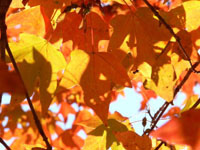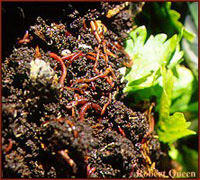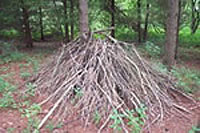Fall Tips
Do A Little, Save A Lot
When the sticky humidity of summer gives way to warm days and chilly nights, it is the perfect time to think about saving energy. Home is a great place to start. However, saving energy and improving air quality when buying produce, driving to work or going to school are also great options. Looking to make some energy-efficient improvements to your home? Visit the Focus on Energy Home Energy Rebate page for information on currently available rebate programs and upcoming federally funded rebate opportunities.
Yard Care
Autumn Yard Care
sunlight.
The average adult breathes about 20,000 times each day. Both children and the elderly face a greater risk of being affected by air pollution, as do people with heart, respiratory or other ailments.
Burning leaves and other debris generates air pollution, is a health hazard to people with asthma and other allergies and is a fire hazard and nuisance to neighbors. There are good alternatives to open burning.
Using yard debris at home saves the tax dollars spent to collect and process leaves, cuttings and clippings while reusing natural materials to beautify the yard.
Fall is an excellent time of year to start composting, or for those who already compost, to think about improvements. Effective yard care reduces waste and recycles organic materials. It also gives the air a break from the hazardous pollutants that burning releases.
Seven Simple Alternatives To Open Burning
nutrients to the soil while
reducing air pollution.
1. Mulching leaves in place. Leaves are rich in carbon, phosphorus and potassium, all essential nutrients needed by plants, including turf grasses. Simply mow leaves along with the grass during fall and let the small leaf pieces filter down among the grass blades.
2. Composting is a natural recycling process that can be done at home with lawn and garden waste. Microorganisms from the soil interact with compost materials to help break down plant matter. Proper moisture, air and temperature aid these microorganisms in their work. Finished compost is used as an organic plant food and soil amendment.
Tip: Save coffee grounds! Coffee beans release lots of nitrogen into the soil and plants love nitrogen. Sprinkle coffee grounds into a garden and watch it flourish.
- Home Composting: Reap A Heap of Benefits [PDF]
- Hmong Translation: Ua chiv tom vaj tom tsev [PDF]
- Spanish Translation: Compostaje casero [PDF]
- Home Composting: The Basic Composter [PDF]
- Yard Care: Do Your Share! [PDF]
- Compost Council of Canada [exit DNR]
3. Grasscycling is leaving grass clippings on the lawn to decompose. Grass clippings are mostly water. When mowing regularly, clippings quickly decompose and release nutrients to fertilize the lawn. Research shows that when grass clippings are left on the lawn, one-third less fertilizer is needed to achieve the same color and grass density found on lawns where the clippings are removed.
4. Mulching. Mulch helps soil retain moisture, moderates temperature fluctuations and reduces erosion and soil compaction. Yard wastes such as grass clippings, leaves and chipped or shredded brush and branches can be used as organic mulches. To save on the cost of buying mulch next year, chop up leaf piles with a lawnmower. Rake up the leaf pieces then store them over the winter in sacks or chicken wire cages. In the spring, spread the chopped-up leaves on gardens as home-grown mulch!
handful of compost.
5. Vermicomposting. Red worms live in the upper layer of the forest floor. These worms can turn food waste into nutrient-rich humus for gardens and houseplants. Use a worm composting bin or vermicomposting bin to make a valuable soil amendment out of old newspapers, vegetable food scraps, trimmings from house plants, yard waste and other organic materials that would normally be thrown away.
6. Alternative landscaping. If a big yard is not being used for activities, consider planting an area of prairie grasses, native shrubs or trees. Using native plant species reduces the need for watering, mowing and pesticide use.
for wildlife.
7. Make a brush pile for wildlife. In more natural settings, yard brush and branches can be reused to form a brush pile for wildlife. Brush piles provide shelter, nesting and den sites for chipmunks, woodchucks, weasels, skunks, red fox, numerous bird species, garter snakes, salamanders and more.
Going To School
Going To School - The Green Way
It is that time of year again, back to school. Now is a great time for getting kids off on a green foot.
- Kid power is one of the best modes of transport. Walking, biking, skateboarding and pushing a scooter have been proven to be environmentally friendly ways of getting to school. If walking to school is not an option, taking the bus is the next best thing. The bus is a safe and energy-saving way to get kids to school.
- Shop for green school supplies. Everything from pencils made from recycled materials, to backpacks constructed from plastic bottles, even recycled notebooks can be found.
- When buying school supplies, look for paper and plastic products that contain recycled content. On notebooks, folders and other paper products, look for "made from recycled content" or "30% post-consumer paper."
- Pack a healthy lunch from organic or locally grown food. Pack some cloth napkins to go with lunch.
- Instead of plastic or paper bags, use reusable cloth bags and plastic containers. Invest in a reusable plastic or metal container for carrying drinks, rather than purchasing single-use water bottles or juice boxes.
- For teaching activities, check out Environmental Education for Kids! (EEK!) [exit DNR].
For more information on green back to school tips, see Recycling and waste reduction for all seasons.
Local Food
Buy Local Food
Purchase local produce and help reduce air emissions. Fresh produce travels more than 1,500 miles on average before being eaten. That is approximately the distance from Wisconsin to Arizona! Tractor-trailers, which haul much of the produce, get about 6 miles to a gallon of diesel fuel. Even though they can hold a lot of veggies per load, the emissions add up. For example, each gallon of diesel fuel emits 22 pounds of carbon dioxide, the main greenhouse gas contributing to climate change.
Driving a tractor-trailer 1,500 miles (not including idling time) emits about 5,550 pounds of carbon dioxide, which is almost the same as what an average passenger car emits in seven months! Other air pollutants released in vehicle exhaust include nitrogen oxides, carbon monoxide, volatile organic compounds and particle pollution. Wisconsin is lucky to have farmers markets around the state where fresh produce can be purchased directly from growers. Find out about farmers markets in Wisconsin.
Grocery stores are carrying more local produce because of consumer demand. Ask the grocer where the store's produce comes from and let them know local products are preferred.
At Work
At Work
quality at work.
There are many ways to improve air quality while at work.
- Turn off computers, printers, fax machines and lights at night to save energy. Consider putting all electronics on a power strip so they can all be turned off at once when leaving for the day.
- Rather than traveling to the meeting, hold meetings by telephone or video conference, especially during an air quality watch.
- Bring lunch to work instead of driving to get it. It may be cheaper and will save gas, too. If buying lunch, walk to the restaurant; it is healthy and good for the environment.
- Consider a compressed work week. Working four 10-hour days eliminates one round trip every week and traffic may be less congested.
- Take mass transit, share a ride or carpool. Doing so reduces pollution.







